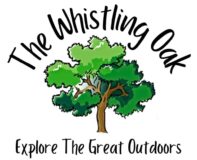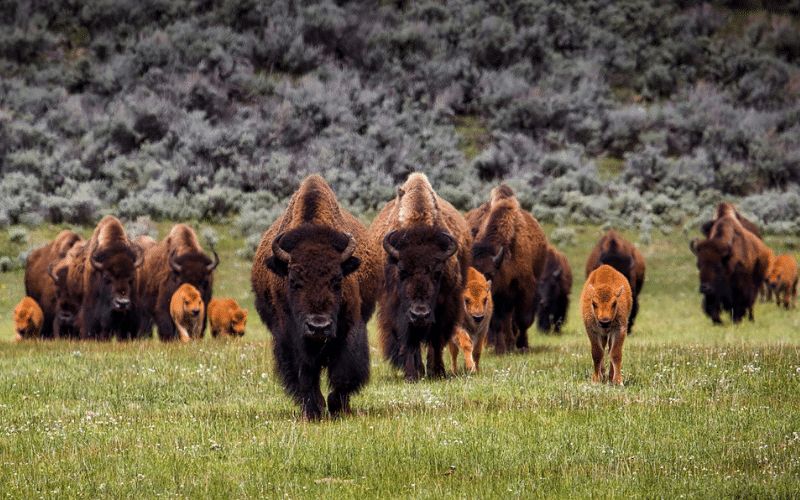Explore animals in Buffalo Gap National Grassland: from iconic bison to elusive ferrets. Dive into South Dakota's wildlife showcase with our detailed guide!
Buffalo Gap National Grassland in South Dakota is a wildlife enthusiast’s paradise.
This expansive region, brimming with biodiversity, offers visitors a chance to spot animals ranging from the iconic bison and agile pronghorn to elusive black-footed ferrets and soaring nighthawks.
For those planning a visit, especially in the crisp ambiance of late fall, anticipate a dynamic showcase of nature.
Dive into our guide as we detail our firsthand experiences and provide insights into the animals you’re most likely to encounter in this vibrant habitat.
Bison
The bison, often regarded as a symbol of the American West, is a majestic animal with a robust body, a thick mane, and a hump over its shoulders.
Their dark brown coats grow thicker during the winter months, serving as insulation against the cold. Powerful and stout-legged, bison can be surprisingly swift for their size.
In Buffalo Gap National Grassland, bison are a testament to nature’s resilience. Having once roamed these lands in vast numbers, they now reclaim their ancestral stomping grounds.
For visitors, the sight of a bison herd grazing amidst the grassland’s rolling plains is nothing short of iconic.
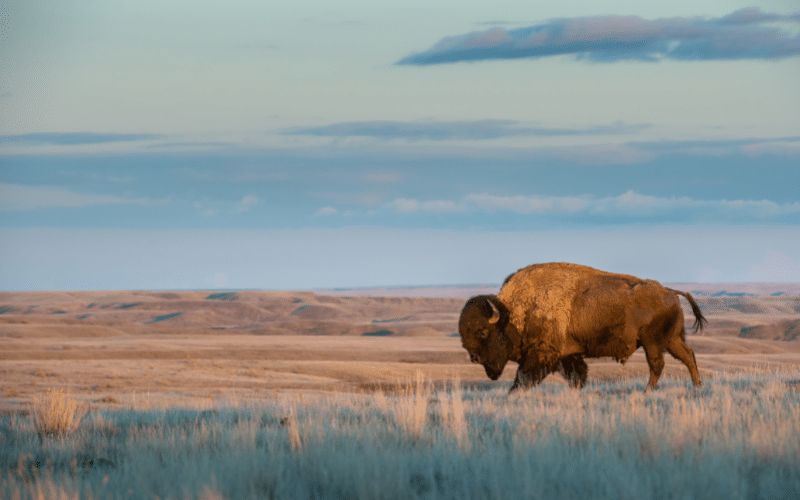
Early mornings or late afternoons are often the best times to observe these creatures, especially around the more open grazing areas.
They can typically be seen in small herds, leisurely grazing or resting together. While bison seem placid, it’s crucial to remember they’re wild animals.
Approaching them can be dangerous; it’s always best to admire from a distance.
An intriguing aspect of the bison in Buffalo Gap is their integral role in the ecosystem. Their grazing habits help in seed dispersal, and they also till the soil with their hooves, promoting plant growth and diversity.
Witnessing the bison is not just about admiring an animal; it’s about appreciating a keystone species that shapes the landscape and ecology of Buffalo Gap National Grassland.
Prairie Dogs
With their stout bodies, short legs, and bright eyes, prairie dogs have a certain charisma that can’t be overlooked. These small, burrowing rodents sport a coat that ranges from tan to light brown, making them well-camouflaged against the grassy terrain.
Their sharp, chattering calls often resonate throughout their colonies, serving as both a greeting and a warning.
Buffalo Gap National Grassland is peppered with prairie dog towns—clusters of burrows that can house hundreds, if not thousands, of these gregarious creatures.
These towns are most active during daylight hours when the prairie dogs can be seen standing upright on their hind legs, scanning their surroundings or playfully interacting with one another.
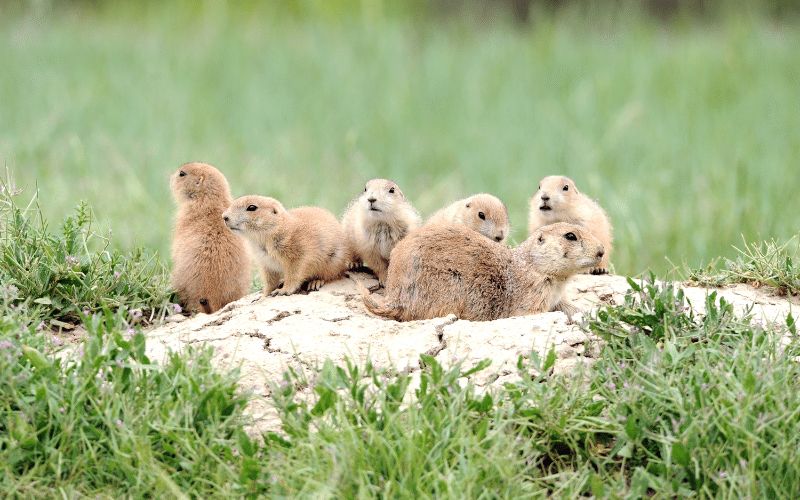
For the best viewing experience, it’s recommended to visit the more expansive grassy regions of Buffalo Gap. These areas often teem with prairie dog activity.
Their intricate burrow systems aren’t just homes; they’re fortresses with designated chambers for sleeping, rearing young, and escaping predators.
A unique feature of the prairie dogs in Buffalo Gap is their role as a keystone species. Their burrowing behaviors aerate the soil, aiding water infiltration and nutrient cycling.
Moreover, their towns offer a rich habitat for other wildlife, from burrowing owls that use abandoned burrows to birds and predators that feed on the prairie dogs.
Observing a prairie dog town in Buffalo Gap offers a window into a bustling microcosm, reflecting the grassland’s interconnected and vibrant ecosystem.
Pronghorn
The pronghorn, often dubbed the “American antelope,” is a sight to behold with its slender, graceful frame, and distinctively marked face.
White fur contrasts with patches of rich brown, and their unique horns, with a forward-facing prong, make them easily distinguishable from other inhabitants of the grassland.
Within the expanse of Buffalo Gap National Grassland, pronghorns roam the open plains, often spotted in small groups.
Renowned for their incredible speed, they are the second-fastest land animals and can reach speeds up to 55 mph. This agility isn’t just for show—it’s a crucial survival tactic to evade predators.
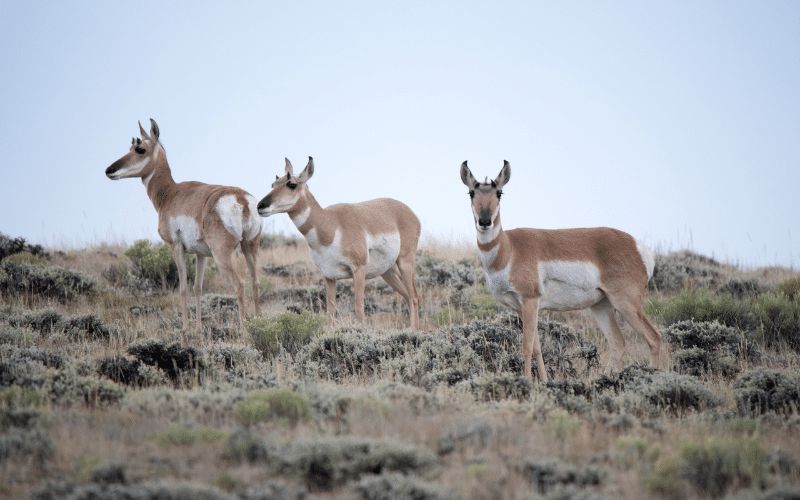
Visitors to Buffalo Gap can usually sight pronghorns grazing or resting in the grasslands, especially in areas where the vegetation is short and offers them a clear line of sight.
Their keen eyesight, often compared to high-powered binoculars, is a testament to their adaptability to the open landscapes.
A fascinating tidbit about pronghorns in Buffalo Gap is their annual migration patterns.
Some herds travel long distances between summer and winter habitats, navigating challenging terrains and obstacles, showcasing their enduring spirit and adaptability.
Badgers
Stocky, low-slung, and powerfully built, badgers are formidable diggers. Their greyish fur, distinct black and white-striped face, and sharp claws are signature traits.
Though mostly nocturnal, their excavations can be readily seen across Buffalo Gap, marked by large mounds of dirt.
The open grassland and prairie dog towns of Buffalo Gap are prime habitats for badgers.
Their diet primarily consists of small rodents, and prairie dog towns are often their favorite hunting grounds.
This predator-prey relationship leads to a fascinating dance of evolution, with prairie dogs developing ever more intricate burrow systems to escape, and badgers continually adapting their hunting strategies.
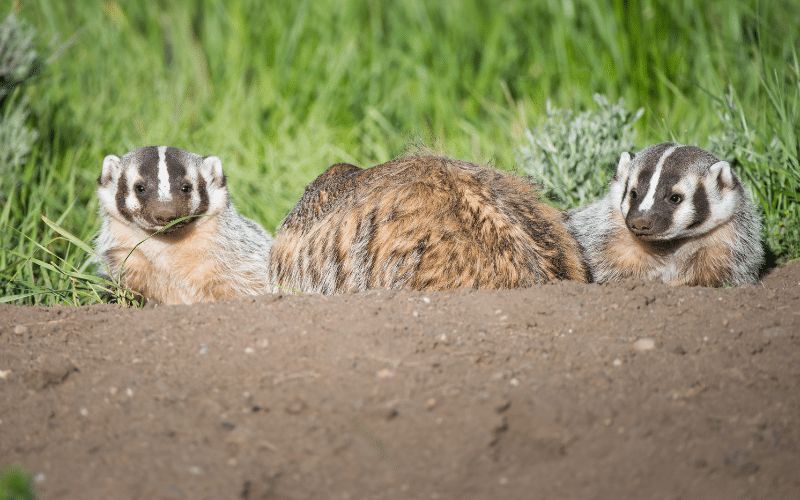
When exploring Buffalo Gap, especially during dusk or dawn, visitors might catch a glimpse of a badger on the prowl or perhaps excavating a new burrow.
Despite their somewhat gruff appearance, badgers play a critical role in the ecosystem.
Their digging habits not only control rodent populations but also help in soil aeration, promoting a healthier grassland.
A little-known fact about badgers in this region is their occasional partnerships with coyotes.
This unlikely duo has been observed hunting together, with the badger pursuing prey underground and the coyote chasing those that escape to the surface—a testament to the complex and dynamic relationships within Buffalo Gap’s ecosystem.
Black Footed Ferrets
Among the most elusive inhabitants of Buffalo Gap National Grassland are the black-footed ferrets.
Sleek and agile, these nocturnal mammals are characterized by their dark legs and a bandit-like mask that contrasts with their pale body.
Their lithe build allows them to navigate the complex burrow systems they call home.
Black-footed ferrets have an intimate relationship with prairie dog towns within Buffalo Gap.
These towns are essential for their survival, as prairie dogs are their primary prey. It’s this dependence that once led to the decline of black-footed ferrets as prairie dog populations dwindled.
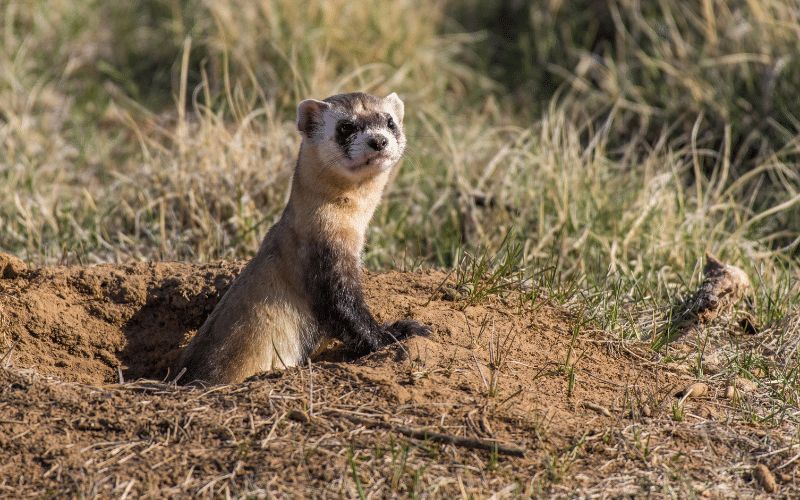
Fortunately, conservation efforts within the grassland have seen a resurgence of these captivating creatures.
Spotting a black-footed ferret in Buffalo Gap is a rare treat, mostly due to their nocturnal habits and stealthy nature.
The best chances lie around prairie dog colonies during the night, especially when the moon is bright.
Visitors lucky enough to witness these animals get a firsthand look at a conservation success story, as these ferrets were once thought to be extinct.
An interesting note on these ferrets is their intricate dance with prairie dogs.
While they prey on them, they also utilize their burrows for shelter, resulting in a complex balance of predator and environment utilization that’s enthralling to observe.
Bighorn Sheep
Majestic and sure-footed, bighorn sheep are a symbol of the rugged terrains they inhabit.
Males, or rams, sport massive, spiraled horns that can weigh up to 30 pounds, while females, or ewes, have shorter, more slender horns.
Their brown to gray coats provide them with effective camouflage against the rocky landscapes.
In Buffalo Gap National Grassland, bighorn sheep often gravitate towards the steeper, rocky regions where their incredible climbing skills shine.
Their hooves have adapted to grip even the most precarious ledges, making them masters of their mountainous domains.
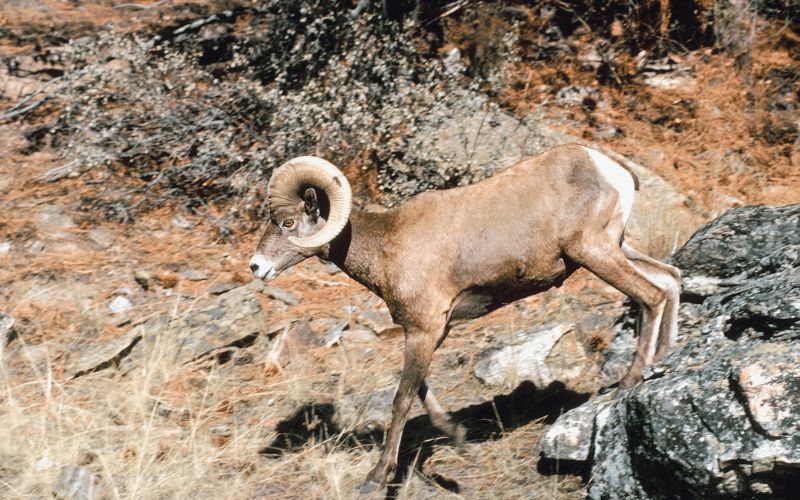
For those aiming to see bighorn sheep in the wild, it’s advisable to scan the rocky outcrops and cliffs of Buffalo Gap during early mornings or late afternoons.
These are the times when they’re most active, either grazing on the sparse vegetation or navigating the rocky terrains with an elegance that belies their size.
A particularly awe-inspiring spectacle that Buffalo Gap visitors might witness is the clash of rams during the mating season.
Their head-butting contests, where they charge at each other with thunderous impact, are a testament to their strength and dominance rituals.
These moments, resonating with raw power, showcase the sheer vitality of life within the grassland.
Deer
Graceful and gentle, deer are a familiar sight in many North American landscapes, and Buffalo Gap National Grassland is no exception.
Primarily, the mule deer, with its large, mule-like ears and white tail tipped with black, can be spotted within the grassland.
Their sleek, tawny coats blend seamlessly into the vast expanse of grass and shrubbery.
Within Buffalo Gap, deer frequent the grassy meadows and areas with dense brush, especially during the early morning and late afternoon when they come out to graze.
As herbivores, they play a crucial role in the grassland ecosystem, helping to control vegetation growth.
Visitors keen on observing deer should approach quietly and maintain a respectful distance.
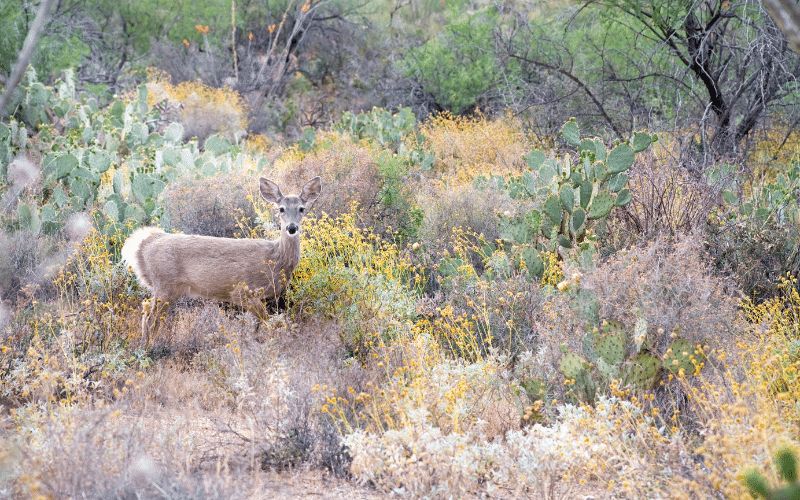
While generally skittish, the deer in Buffalo Gap have occasionally been known to display curiosity towards human presence.
An interesting aspect of deer in this region is their adaptability. Despite facing threats from predators and environmental challenges, they’ve honed their senses and agility to thrive in this vast grassland.
Coyotes
The haunting call of the coyote is a sound that embodies the spirit of the American wilderness.
These adaptable canids, with their sharp features and tawny to grayish coats, are a common sight within Buffalo Gap National Grassland.
Though often mischaracterized as mere scavengers, coyotes are skilled predators and play a pivotal role in maintaining the balance of the ecosystem.
Coyotes are incredibly versatile, thriving in both open plains and densely vegetated areas of Buffalo Gap.
They hunt primarily during dawn and dusk, their keen senses attuned to the slightest rustle or movement.
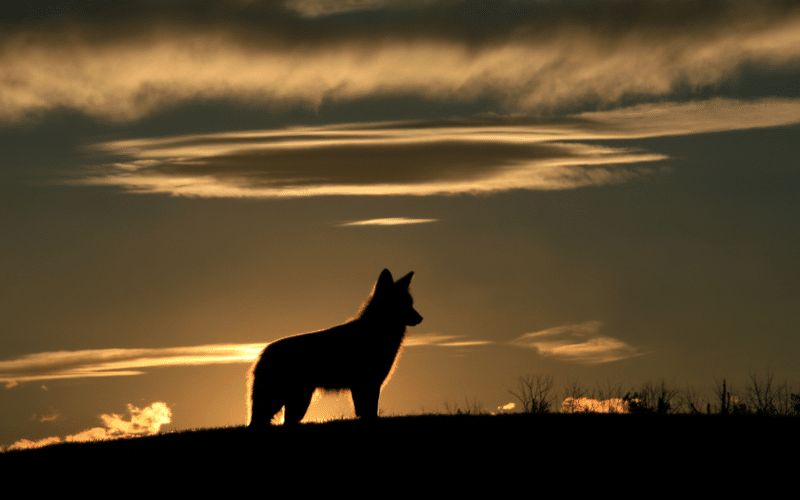
While they primarily prey on small mammals, they’re also known to consume fruits, insects, and occasionally larger prey.
For visitors, observing a coyote in its natural habitat is an insightful experience. Their intelligent eyes and playful antics often defy their reputation.
Intriguingly, as mentioned earlier, coyotes in Buffalo Gap have sometimes been observed forming hunting partnerships with badgers, a testament to their adaptability and the intricate web of relationships that defines the grassland ecosystem.
Jackrabbits
With their impressively long ears and powerful hind legs, jackrabbits are a notable presence in Buffalo Gap National Grassland.
Their sleek, grayish-brown fur allows them to blend seamlessly into the grassland’s backdrop, providing a natural camouflage against potential threats.
These swift creatures are not true rabbits but are actually hares. Within Buffalo Gap, they thrive in the open expanses, relying on their speed and agility to evade predators.
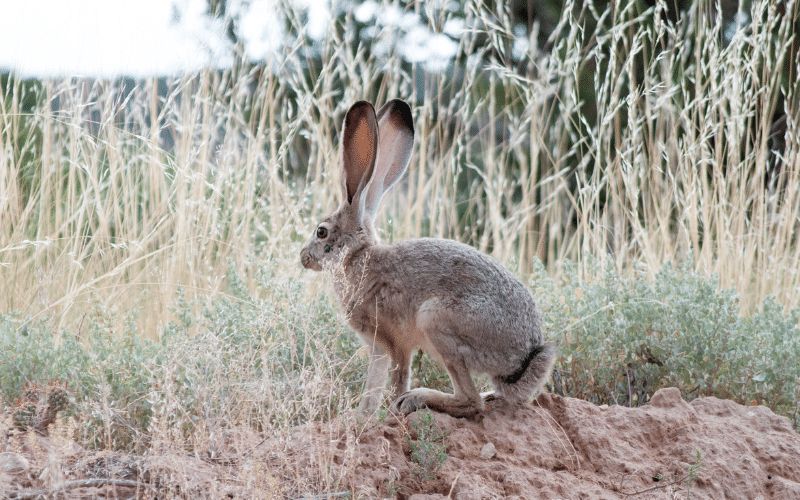
Often, the best time to spot them is during the cooler hours of dawn or dusk as they venture out to forage. Their diet primarily consists of grasses and shrubs native to the region.
An intriguing feature of jackrabbits in Buffalo Gap is their ability to regulate body temperature.
Their large ears serve as heat radiators, helping them to dissipate excess warmth during hotter months.
Observing the grace and swiftness of these hares against the vast grassland horizon is truly a sight to cherish.
Red Fox
With its fiery red coat, bushy tail, and sharp, pointed ears, the red fox is a picture of elegance and cunning.
This adaptable predator is one of the most widespread wild canids, and Buffalo Gap National Grassland is among its many homes.
Within the vastness of the grassland, red foxes establish their dens often at the edges of dense vegetation or along the slopes.
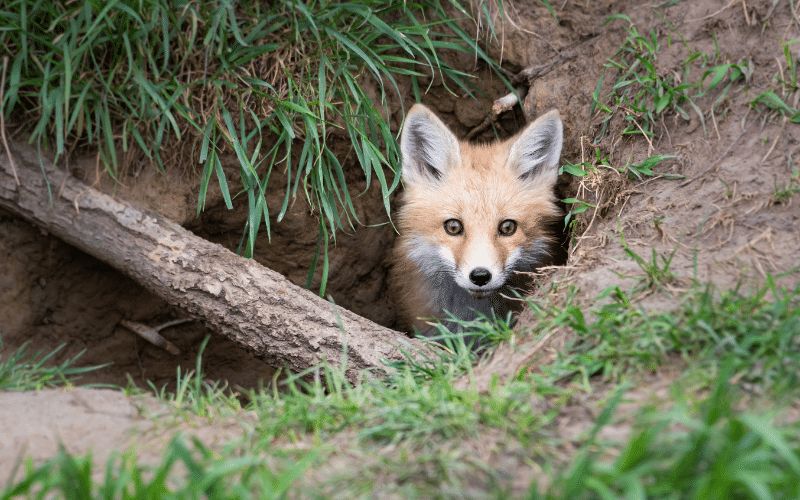
They are primarily nocturnal, though sightings during twilight are not uncommon. These foxes are opportunistic hunters, feasting on small mammals, birds, and even insects.
Visitors to Buffalo Gap might be treated to the sight of a red fox stealthily stalking its prey or playing with its kits near its den.
A particularly enchanting aspect of the red fox in this region is its vocalization—a series of barks, yips, and howls that add an ethereal soundtrack to the grassland nights.
Their keen senses and graceful movements are a testament to their evolved survival tactics in such a diverse habitat.
Porcupine
A creature of quills and curiosity, the porcupine is a standout resident of Buffalo Gap National Grassland.
Covered in a protective armor of sharp, barbed quills, these medium-sized rodents possess a brownish-black fur that often goes unnoticed beneath their formidable spines.
In the diverse terrains of Buffalo Gap, porcupines are primarily arboreal, often found clambering up trees and shrubs, feasting on their tender bark.
Their slow-paced movement is counterbalanced by their quills, which serve as a defense mechanism against predators. If threatened, a porcupine can raise and fan out these quills to appear larger and more menacing.
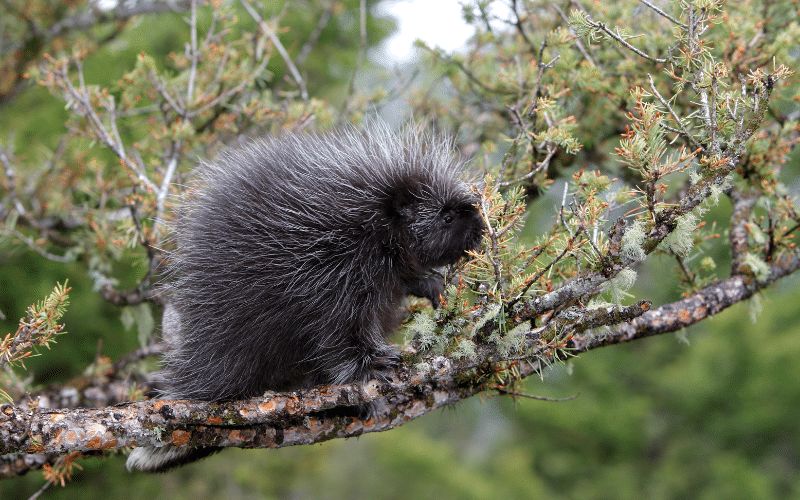
For those wandering the grassland, the rustling of leaves might hint at a porcupine’s presence overhead.
A fascinating trait of Buffalo Gap porcupines is their penchant for gnawing on objects, often leaving behind telltale tooth marks.
This behavior not only helps them maintain sharp teeth but also fetches vital minerals from the items they chew.
Nighthawks
With their sleek silhouette and distinctive white wing bars, nighthawks add a touch of aerial mystique to Buffalo Gap National Grassland.
These birds, despite their name, aren’t hawks but belong to the nightjar family. Their mottled gray and brown plumage ensures they blend seamlessly into the grassland during daylight hours.
In the vast expanse of Buffalo Gap, nighthawks come alive during the crepuscular hours, darting and swooping to catch flying insects in mid-air.
Their erratic flight pattern, often accompanied by a unique “peent” call, makes them a captivating sight against the twilight sky.
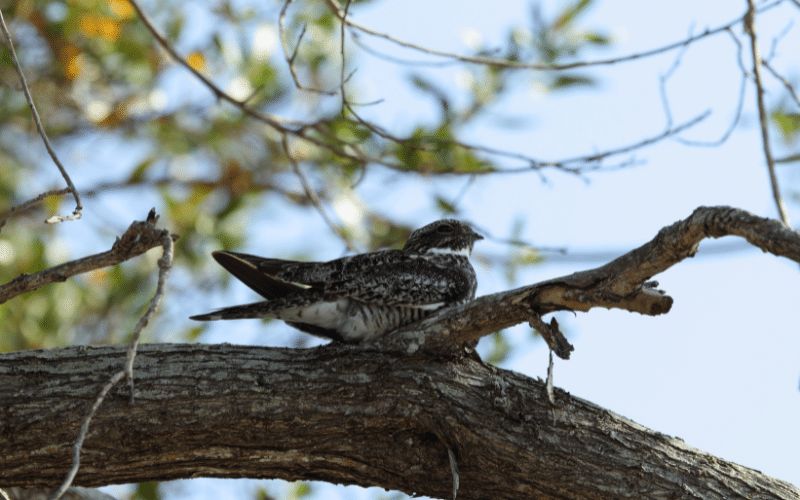
Visitors to the grassland, especially during the evening, can enjoy the acrobatics of nighthawks as they perform their aerial feats.
An interesting aspect of Buffalo Gap nighthawks is their ground-nesting behavior. Their camouflaged eggs are laid directly on bare soil or among gravel, a clever tactic to keep them hidden from potential predators.
The adaptation of these birds to their environment—both in flight and nesting—is a remarkable testament to the dynamic life of the grassland.
Northern Harrier
Gliding gracefully over the grasslands, the Northern Harrier is a sight to behold with its long wings and distinct white rump patch.
Males exhibit a grayish hue, while females and juveniles don a rich brown plumage, making them easy to differentiate as they soar over Buffalo Gap.
In the vast stretches of Buffalo Gap National Grassland, this raptor prefers the open terrains, relying on its keen hearing and sight to hunt small mammals and birds.
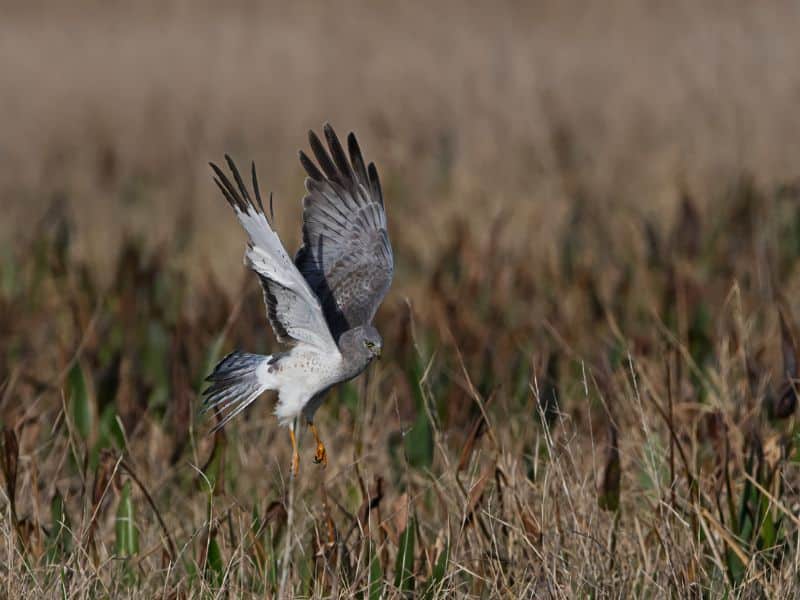
The owl-like facial disc helps in directing sound to its ears—a unique feature among hawks. Early morning and late afternoon are the best times to observe their ground-skimming flights.
A captivating aspect of Northern Harriers in Buffalo Gap is their ground-nesting behavior. Nestled amidst tall grasses, their nests are hidden gems, protecting eggs and chicks from predators.
Their aerial displays, especially during mating season, accentuate the dynamic tapestry of the grassland’s sky.
Rattlesnakes
Slinking through the shadows, rattlesnakes are the revered reptiles of Buffalo Gap National Grassland. With their diamond-shaped heads, patterned scales, and iconic rattling tail, these snakes are both admired and feared.
Their cryptic coloration matches the earthen tones of the grassland, providing effective camouflage.
Rattlesnakes are apex predators in Buffalo Gap, preying on rodents, birds, and other small animals. They employ a sit-and-wait strategy, relying on their heat-sensing pits to detect warm-blooded prey.
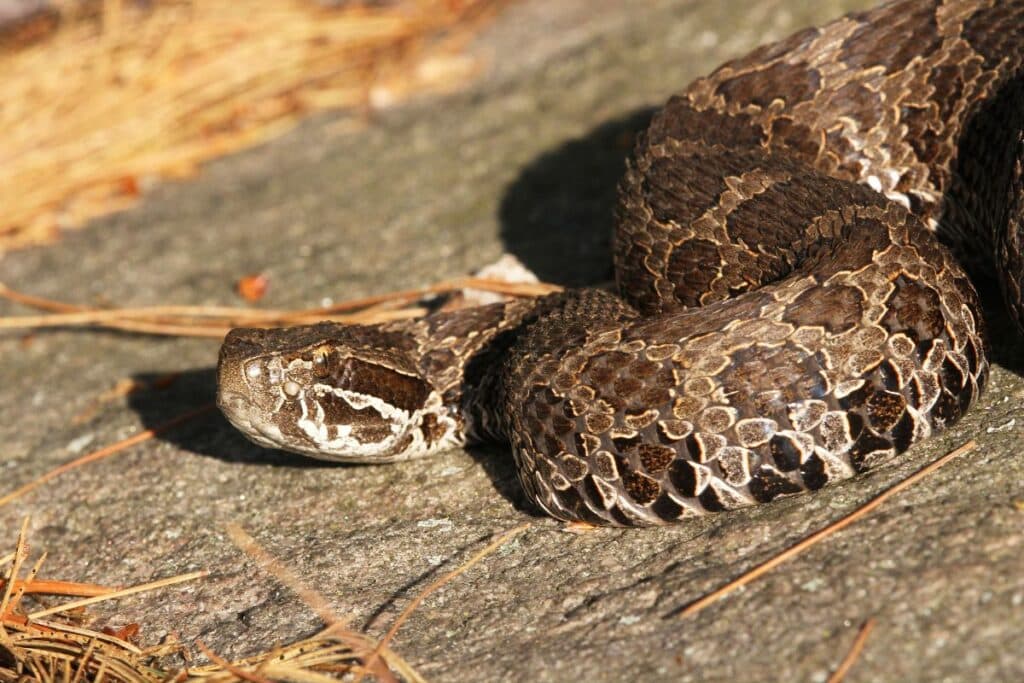
When threatened, the rattling sound they produce serves as a warning, a clear sign for one to keep their distance.
Visitors should exercise caution while navigating areas with dense vegetation or rock crevices, typical hideouts for these snakes.
Interestingly, rattlesnakes play a vital role in the grassland ecosystem, controlling rodent populations and serving as indicators of environmental health.
Their presence, while intimidating, underscores the delicate balance of life in Buffalo Gap.
Burrowing Owls
Standing tall on long legs, with bright yellow eyes and a mottled brown plumage, burrowing owls are a charming addition to Buffalo Gap’s avian community.
Unlike most owls, these petite raptors are diurnal, active during the day, especially during dawn and dusk.
Buffalo Gap’s open grasslands, dotted with abandoned mammal burrows, serve as ideal habitats for these owls. Rather than nesting in trees, they take up residence in these burrows, lending them their name.
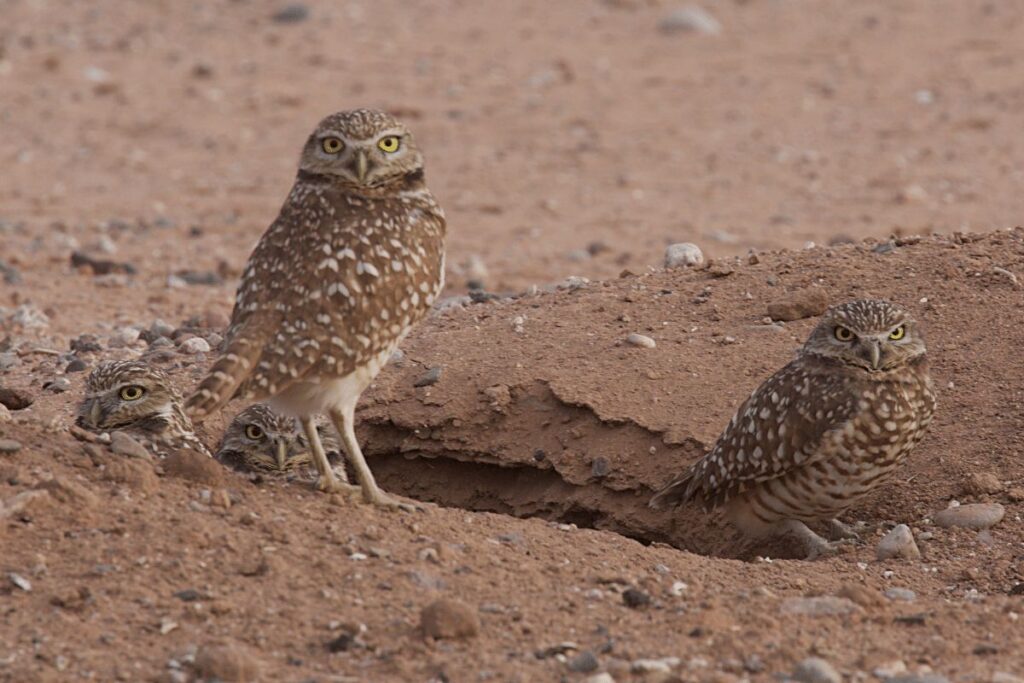
Their diet consists of insects, rodents, and small birds, which they hunt with a keen eye and swift agility.
One of the delightful sights in Buffalo Gap is a burrowing owl perched near its home, often using dung to decorate the entrance—a strategy to lure dung beetles, a tasty snack.
These owls, with their head-tilting curiosity and endearing demeanor, epitomize the intricate relationships and adaptations that define the inhabitants of the grassland.
Buffalo Gap National Grassland Ecosystem
Buffalo Gap National Grassland, encompassing a vast expanse in southwestern South Dakota, is a testament to nature’s resilience and adaptability.
While often overshadowed by forests and wetlands in terms of biodiversity, grasslands like Buffalo Gap offer an ecosystem that’s uniquely rich and balanced.
The landscape of Buffalo Gap is defined by rolling plains of grasses, punctuated occasionally by shrubs, rocky outcrops, and a sprinkling of water sources. These grasses, the primary producers, form the foundation of the ecosystem.
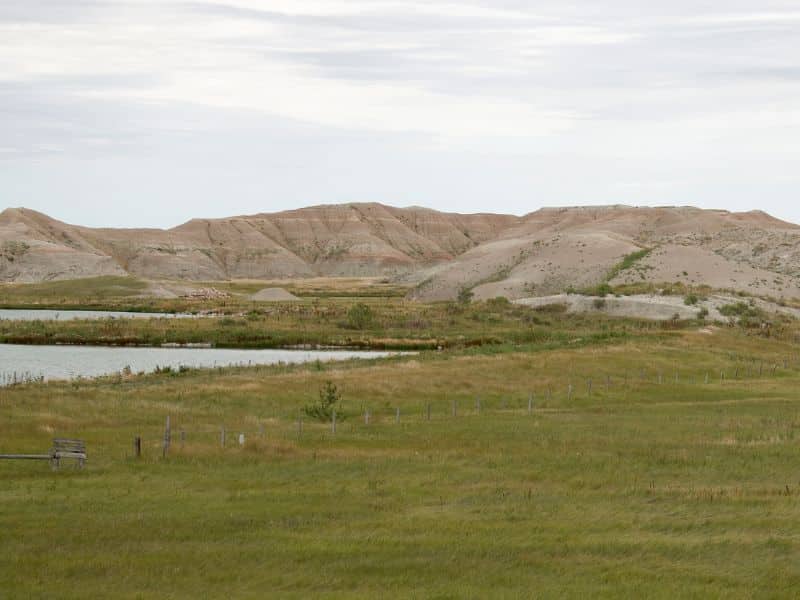
They convert sunlight into energy, supporting a wide range of fauna, from insects and birds to mammals and reptiles.
Their deep-root systems hold the soil together, preventing erosion and ensuring water retention, playing a crucial role in maintaining the health and sustainability of the environment.
This grassland is a haven for herbivores like bison, pronghorns, and deer, which graze on its vast pastures. In turn, these herbivores sustain populations of predators such as coyotes, badgers, and raptors.
The balance between predator and prey, along with factors like disease, weather patterns, and human intervention, shapes the dynamics of Buffalo Gap’s ecosystem.
One of the remarkable features of Buffalo Gap is its role as a refuge for many endangered and threatened species. Creatures like the black-footed ferret, once on the brink of extinction, have found sanctuary within this grassland.
The ecosystem’s natural checks and balances, paired with conservation efforts, offer hope for these species’ survival.
Water sources within Buffalo Gap are few but vital. They support unique aquatic life and serve as hydration points for larger mammals. These water bodies also attract a plethora of birds, making the grassland a birdwatcher’s paradise.
Buffalo Gap isn’t just about flora and fauna. The soil, the air, the changing seasons, and even the fires, which play a pivotal role in nutrient recycling and maintaining diversity, all intertwine to form this living, breathing ecosystem.
10 Tips to See Wildlife in the Buffalo Gap National Grassland
- Dawn and Dusk are Prime Times: Many animals are crepuscular, meaning they are most active during the early morning and late evening. Visiting during these hours increases your chances of spotting wildlife.
- Tread Lightly: Move quietly and maintain a low profile. Wildlife is often wary of human presence, so minimizing noise and sudden movements will make you less disruptive.
- Equip Yourself: Binoculars and a good field guide are invaluable tools. They allow you to observe animals from a distance without disturbing them and help you identify the creatures you come across.
- Stay on Marked Trails: While the urge to venture off the beaten path is tempting, sticking to designated trails minimizes environmental impact and reduces the chance of unintentionally approaching animals’ nesting or resting areas.
- Dress Appropriately: Wearing neutral-colored clothing can make you less noticeable to wildlife. It also helps to dress in layers, as temperatures in grasslands can fluctuate.
- Be Patient: Wildlife watching is as much about patience as it is about luck. Spend some time sitting quietly in one spot and let the animals come to you.
- Be Aware of Seasonal Movements: Different times of the year bring various wildlife activities. For instance, spring might be ideal for birdwatching during migrations, while fall could be perfect for observing larger mammals.
- Avoid Feeding the Animals: While it might seem like a gesture of kindness, feeding wild animals can harm their health, alter natural behaviors, and expose them to predators.
- Educate Yourself Beforehand: Learn about the specific behaviors and habitats of animals you’re keen to see. Knowing where an animal is likely to feed, rest, or play can significantly improve your chances of spotting it.
- Respect the Wildlife and Environment: Always remember you’re a visitor in their home. Keep a safe distance, avoid causing stress to the animals, and practice “Leave No Trace” principles to ensure the beauty and biodiversity of Buffalo Gap National Grassland remains for generations to come.
Conclusion
Our camping adventures gave us a new appreciation for what makes the park so spectacular. From the many different plant species to the countless animals that roam the land, there is so much to explore at Buffalo Gap National Grasslands. We really do hope you will visit and let us know how your trip goes!
